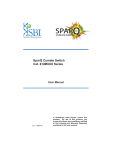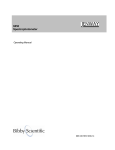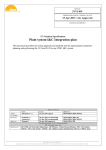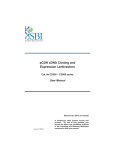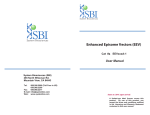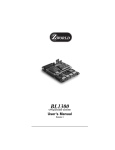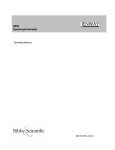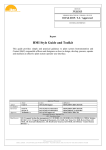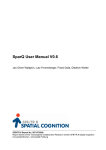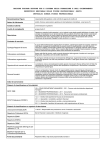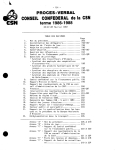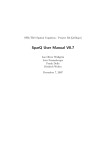Download SparQ Cumate Switch User Manual
Transcript
SparQ Cumate Switch Cat. # QMXXX Series User Manual (ver. 1-090810) A limited-use label license covers this product. By use of this product, you accept the terms and conditions outlined in the Licensing and Warranty Statement contained in this user manual. SparQ™ Cumate Switch Inducible Expression System Cat#s QMxxx Contents I. Introduction and Background ..................................................1 A. Purpose of this Manual .......................................................1 B. Features and Benefits of the Cumate Switch Inducible System C. Mechanism of Transcriptional Control ................................3 D. Advantages of the SparQ Lentivector Expression System .4 E. SparQ™ Cumate Switch Map examples ............................6 F. List of the Cumate Switch Components ............................10 1 G. Additional Required Materials ...........................................11 H. II. Safety Guidelines ..............................................................11 Protocols ...............................................................................13 A. Transduction the CymR Repressor and Inducible Viruses ...13 B. Induction and Monitoring expression ...................................14 III. Troubleshooting ................................................................14 A. No or low RFP/GFP observed under a fluorescent microscope after the addition of cumate for the T2A and IRES formats. ............................................................................14 IV. References ........................................................................15 V. Appendix ...............................................................................16 A. Features of the Lentivectors: ................................................16 B. Related Products ..................................................................17 C. Technical Support .................................................................18 VI. I. Licensing and Warranty Statement ...................................19 Introduction and Background A. Purpose of this Manual This manual provides detailed information on how to use SBI’s tightly regulated SparQ™ Lentiviral Cumate Switch Inducible system. For new users of the system, please read the entire manual before starting. The SparQ cumate switch lentivectors work through virus transduction. Transfection of the vectors will result in constitutive expression from the upstream RSV packaging promoter. B. Features and Benefits of the Cumate Switch Inducible System • • Avoid potential undesired effects from constitutive overexpression Enhanced Cumate Operator (CuO) elements regulate the potent CMV5 promoter 888-266-5066 (Toll Free) 650-968-2200 (outside US) Page 1 System Biosciences (SBI) • • • • • • • User Manual Extremely low background with robust Cumate-On induction Track induction with co-expressed RFP or GFP markers Two lentivector system: CymR lentivirus plus your inducible construct CymR lentivectors available with co-expressed Puro or RFP markers Easy to titrate level of induction with cumate solution Switch ON → Turn OFF → Switch ON again capabilities No special media or conditions required, plug and play system Page 2 ver. 1-090110 www.systembio.com SparQ™ Cumate Switch Inducible Expression System Cat#s QMxxx C. Mechanism of Transcriptional Control The regulatory mechanisms of the bacterial operons cmt and cym have been engineered to regulate gene expression in mammalian cells. In the repressor configuration, regulation is mediated by strong binding of the CymR repressor to the Cumate operator site (CuO), which is downstream of the CMV5 promoter. Addition of cumate, a small non-toxic molecule, relieves the repression. 888-266-5066 (Toll Free) 650-968-2200 (outside US) Page 3 System Biosciences (SBI) User Manual D. Advantages of the SparQ Lentivector Expression System SBI has built the only lentivector-based cumate switch system providing inducible expression of cDNAs and microRNAs. Top features of the Cumate Switch 1) Tighter regulation of induction The Cumate Switch has lower background than other inducible systems and provides robust induction levels. Page 4 ver. 1-090110 www.systembio.com SparQ™ Cumate Switch Inducible Expression System Cat#s QMxxx 2) Titratable and controllable induction of expression Cumate is non-toxic to cells and allows for greater dynamic ranges of induction levels, allowing you to choose your induction level. HEK293 cells stably expressing CymR (Cat.# QM400A-1) and transduced with pCDH-Cuo-RFP-T2A-copGFP positive control virus (Cat. # QM350VA-1) at MOI=20. Increasing amounts of cumate were added. The cells were imaged after 3 days. The same HEK293-CymR cell line was transduced with increasing MOIs of pCDH-Cuo-RFP-T2A-copGFP virus and treated with 30μg/ml cumate. 888-266-5066 (Toll Free) 650-968-2200 (outside US) Page 5 System Biosciences (SBI) User Manual 3) Switch On, turn OFF and Switch back ON capabilities The Cumate switch SparQ lentivectors can be induced for multiple rounds by simply adding and removing cumate. E. SparQ™ Cumate Switch Map examples SparQ Cumate Inducible Lentivectors and CymR Repressor Formats Page 6 ver. 1-090110 www.systembio.com SparQ™ Cumate Switch Inducible Expression System Cat#s QMxxx The Dual promoter, T2A and IRES SparQ vector formats can be used to make inducible expression constructs for cDNA. We recommend using either the Dual promoter or IRES vector formats for creating inducible microRNA expression constructs. NOTES: The Dual promoter format vectors will constitutively express RFP or GFP independent of the cumate switch activation. The T2A and IRES formats will express the GFP or RFP markers only when the cumate switch is turned ON. Catalog # Inducible Configuration QM350PA-1 QM500A-1 pCDH-Cuo-RFP-T2A-copGFP positive control (plasmid) pCDH-Cuo-RFP-T2A-copGFP positive control (virus) pCDH-CuO-MCS empty QM511B-1 pCDH-CuO-MCS-EF1-copGFP QM350VA-1 888-266-5066 (Toll Free) 650-968-2200 (outside US) Page 7 System Biosciences (SBI) User Manual QM512B-1 pCDH-CuO-MCS-EF1-RFP QM521A-1 pCDH-CuO-MCS-T2A-copGFP QM522A-1 pCDH-CuO-MCS-T2A-RFP QM530A-1 pCDH-CuO-MCS-IRES-copGFP QM531A-1 pCDH-CuO-MCS-IRES-RFP Catalog # Repressor Formats QM200PA-1 pCDH-EF1-CymR-T2A-Puro (plasmid) QM200VA-1 pCDH-EF1-CymR-T2A-Puro (virus) QM300PA-1 pCDH-EF1-CymR-T2A-RFP (plasmid) QM300VA-1 pCDH-EF1-CymR-T2A-RFP (virus) Confirm identity of the cDNA insert by sequence analysis of the construct using the one of the PCR primers. Alternatively, you may use the following sequencing primer which is located upstream of the MCS: Vectors with Cumate Operator: 5’-CACCTGGCCCGATCTGGCC-3’ 2A Peptide-enabled dual expression system Co-expression of a reporter gene together with a gene of interest is a useful approach for selecting transfected or transduced cells. This is commonly achieved by using two independent internal promoters, such as CMV and EF1 in pCDH-CMV-MCS-EF1-copGFP, or by linking two transgenes with an internal ribosomal entry site (IRES) element in a single bicistronic transcript. The “self-cleaving” 2A peptides have been used successfully to generate multiple proteins from a single promoter in many applications. The 2A-like sequences exist in several viruses and are used to mediate protein cleavage from a Page 8 ver. 1-090110 www.systembio.com SparQ™ Cumate Switch Inducible Expression System Cat#s QMxxx single open reading frame. Through a ribosomal skip mechanism, the 2A peptide prevents normal peptide bond formation between the 2A glycine and the 2B proline without affecting the translation of 2B: T2A Peptide 2A 2B GeneA E G R G S L L T C G D V E E N P G P GeneB SBI’s cDNA expression vectors incorporate the 2A-like sequence (T2A) from the insect virus Thosea asigna to mediate the co-expression of a reporter gene with the target cDNA. Reporter genes have been cloned at either the first or second positions, and high expression levels can be achieved at both locations. Primer Design for Cloning into Vectors with T2A Sequence Since the gene of interest and the reporter gene in cDNA expression vectors containing a T2A peptide sequence will form one open-reading frame, extra attention should be paid when designing the 3’ primer for amplifying the target sequence. First of all, do not include a stop codon at the 3’ end of target sequence.This would prevent the expression of the reporter gene. Secondly, place the target sequence in-frame with the 2A peptide. For example, if you would like to clone your target sequence between Xba1 and BstB1, you would need to add one more nucleotide at the end of your target sequence in order to make it in-frame with the 2A peptide and reporter gene. Sequence arrangement after target sequence is inserted between Xba1 and BstB1 in cDNA cloning vector pCDH-CuOMCS-T2A-GFP. An additional nucleotide (n) is added after the last codon of the target sequence in order to keep it in frame with the T2A sequence. If you are using either the Dual Promoter or IRES format SparQ cumate switch lentivectors, then include a suitable stop codon at the end of your cDNA prior to the downstream promoter or IRES elements. 888-266-5066 (Toll Free) 650-968-2200 (outside US) Page 9 System Biosciences (SBI) User Manual F. List of the Cumate Switch Components Cat# Description Size QM100A-1 Cumate solution (1000x), 500ul in 95% EtOH 500ul QM200PA-1 pCDH-EF1-CymR-T2A-Puro (plasmid) 10 ug QM200VA-1 pCDH-EF1-CymR-T2A-Puro (virus) >1 x IFUs QM300PA-1 pCDH-EF1-CymR-T2A-RFP(plasmid) 10 ug QM300VA-1 pCDH-EF1-CymR-T2A-RFP (virus) >1 x IFUs QM350PA-1 pCDH-Cuo-rRFP-T2A-copGFP (plasmid) 10 ug QM350VA-1 pCDH-Cuo-rRFP-T2A-copGFP (virus) >1 x IFUs QM511B-1 pCDH-CuO-MCS-EF1-copGFP 10 ug QM512B-1 pCDH-CuO-MCS-EF1-RFP 10 ug QM521A-1 pCDH-CuO-MCS-T2A-copGFP 10 ug QM522A-1 pCDH-CuO-MCS-T2A-RFP 10 ug QM530A-1 pCDH-CuO-MCS-IRES-copGFP 10 ug QM531A-1 pCDH-CuO-MCS-IRES-RFP 10 ug QM500A-1 pCDH-CuO-MCS empty 10 ug Page 10 10^6 10^6 10^6 ver. 1-090110 www.systembio.com SparQ™ Cumate Switch Inducible Expression System Cat#s QMxxx G. Additional Required Materials Packaging of SparQ™ Constructs into Pseudoviral Particles • In order to package your SparQ™ constructs into VSV-G pseudotyped viral particles, we recommend using the pPACKH1 Lentivector Packaging Kit (SBI, Cat. # LV500A-1). The protocols for packaging and transduction of packaged pseudoviral particles are provided in the Lentivector Expression System User Manual. • 293T Producer Cell Line (Recommended: SBI’s 293TN Cell Line, Cat. # LV900A-1) • Transfection Reagent (Recommended: SBI’s PureFection™ transfection reagent, Cat # LV750A-1). Concentrating Pseudoviral Particles • PEG-it™ Virus Precipitation Solution (Cat# LV810A-1) Titer Measurement of Pseudoviral Particles • Global UltraRapid Lentiviral Titering Kit(Cat# LV961A-1) Lentivirus transduction • TransDux™ Virus Transduction Reagent (Cat# LV850A-1) Induction of cDNA or microRNA expression using the cumate switch Catalog # Description • • • • • QM200PA-1 QM200VA-1 QM300PA-1 QM300VA-1 QM100A-1 pCDH-EF1-CymR-T2A-Puro (plasmid) pCDH-EF1-CymR-T2A-Puro (virus) pCDH-EF1-CymR-T2A-RFP(plasmid) pCDH-EF1-CymR-T2A-RFP (virus) Cumate solution (1000x), 500ul, H. Safety Guidelines SBI’s Expression lentivectors together with the pPACK packaging plasmids comprise the third-generation lentiviral expression system. The HIV-based lentivectors are based on the vectors developed for gene therapy applications by Dr. J. G. Sodroski (US patent #5,665,577 and # 5,981,276). Both FIV-based and HIV-based lentivector systems are designed to maximize their biosafety features, which include: • • • • • A deletion in the enhancer of the U3 region of 3’ LTR ensures self-inactivation of the lentiviral construct after transduction and integration into genomic DNA of the target cells. The RSV promoter (in HIV-based vectors) and CMV promoter (in FIV-based vectors) upstream of 5’ LTR in the lentivector allow efficient Tat-independent production of viral RNA, reducing the number of genes from HIV-1 that are used in this system. Number of lentiviral genes necessary for packaging, replication and transduction is reduced to three (gag, pol, rev), and the corresponding proteins are expressed from different plasmids (for HIV-based packaging plasmids) lacking packaging signals and share no significant homology to any of the expression lentivectors, pVSV-G expression vector, or any other vector, to prevent generation of recombinant replication-competent virus. None of the HIV-1 genes (gag, pol, and rev) will be present in the packaged viral genome, as they are expressed from packaging plasmids lacking packaging signal—therefore, the lentiviral particles generated are replicationincompetent. Pseudoviral particles will carry only a copy of your expression construct. 888-266-5066 (Toll Free) 650-968-2200 (outside US) Page 11 System Biosciences (SBI) User Manual Despite the above safety features, use of SBI’s lentivectors falls within NIH Biosafety Level 2 criteria due to the potential biohazard risk of possible recombination with endogenous viral sequences to form self-replicating virus, or the possibility of insertional mutagenesis. For a description of laboratory biosafety level criteria, consult the Centers for Disease Control Office of Health and Safety Web site at: http://www.cdc.gov/od/ohs/biosfty/bmbl4/bmbl4s3.htm. It is also important to check with the health and safety guidelines at your institution regarding the use of lentiviruses and always follow standard microbiological practices, which include: • • • • • • Wear gloves and lab coat at all times when conducting the procedure. Always work with pseudoviral particles in a Class II laminar flow hood. All procedures are performed carefully to minimize the creation of splashes or aerosols. Work surfaces are decontaminated at least once a day and after any spill of viable material. All cultures, stocks, and other regulated wastes are decontaminated before disposal by an approved decontamination method such as autoclaving. Materials to be decontaminated outside of the immediate laboratory area are to be placed in a durable, leakproof, properly marked (biohazard, infectious waste) container and sealed for transportation from the laboratory. Please keep in mind that lentivectors can be integrated into genomic DNA and may have a risk of insertional mutagenesis. Page 12 ver. 1-090110 www.systembio.com SparQ™ Cumate Switch Inducible Expression System II. Cat#s QMxxx Protocols A. Transduction the CymR Repressor and Inducible Viruses Transduce the pCDH-EF1-CymR-T2A-RFP or pCDH-EF1-CymR-T2A-Puro virus either simultaneously with your SparQ cumate switch construct (co-transduce), or establish a stable CymR cell line first. For the best results, we recommend establishing a CymR stable cell line first, and then transducing your inducible SparQ expression virus construct. Co-transducing Target Cells with the Pseudoviruses Day 1. 1) Plate target cells: In each well of a 24-well plate, plate your target cells with 0.5 ml complete growth medium containing antibiotics so that the cells will be 10 – 30% confluent at the time of infection. Incubate the cells at 37°C with 5% CO2 overnight. Day 2 1) Add Transduction reagent: To each well, add TransDux at a final concentration of 1X. 2) Co-Infect target cells with the CymR repressor virus along with the SparQ cumate switch inducible expression virus: 3) To the 24-well plate, add 10, 20 or 50 MOI of each of the packaged viruses. Ideally, a 1:1 ratio of CymR to Cumate switch inducible construct virus provides suitable control of the cumate switch. Use 2-10 µg/ml puromycin to select for stable CymR cells, depending upon your cell type. 888-266-5066 (Toll Free) 650-968-2200 (outside US) Page 13 System Biosciences (SBI) User Manual 4) OPTIONAL: Add cumate solution to the media after at least 30 minutes to induce expression. Cumate is supplied as a 1000x solution in 95% ethanol. An easy way to dilute the cumate solution is to make a 100X cumate solution in the cell media you plan to use for your experiment. A 1X solution of cumate corresponds to30µg/ml. We have tested cumate concentrations between 0.2X and 2X with no toxicity observed in the cells. 5) Incubate the cells at 37°C with 5% CO2 overnight. B. Induction and Monitoring expression 1) Induction: Add Cumate (if you skipped step 4, above) at a final concentration of 1X or desired induction concentration, directly to the wells in which you want to induce the expression of the cDNA or microRNA 24 hours after infection. Continue incubating the cells at 37°C with 5% CO2. 2) Monitor Induction: The Dual promoter format vectors will constitutively express RFP or GFP independent of the cumate switch activation. The T2A and IRES formats will express the GFP or RFP markers only when the cumate switch is turned ON. The level of RFP or GFP expression correlates with the induced expression of your cDNA or microRNA cloned into the SparQ vector construct. Begin monitoring induction after 24 hours, in most cases, easily detectable levels typically occur after 2-3 days. 3) Measurement of microRNA expression: You can generate stable cell lines by sorting for GFP or RFP positive cells depending on the selection marker on the expression vector used. You may also measure the expression levels of your microRNAs using SBI’s QuantiMir Kit (Cat# RA420A-1). 4) Turning OFF the cumate switch: The cumate switch can be turned OFF at any time. Simply remove and change the media of the cells and add fresh media excluding the cumate. The induced expression will fade within 24-72 hours. 5) Turning the cumate switch back ON: The cumate switch can be turned back on to test for repeated expression of your cDNA or microRNA of interest. Simply add cumate back to the cell media whenever you want to induce the expression again. III. Troubleshooting A. No or low RFP/GFP observed under a fluorescent microscope after the addition of cumate for the T2A and IRES formats. 1) The amount of viruses used for infection is too low: Increase the MOI of the viruses for infection. 2) Optimize the ratio of the expression and transactivator viruses: Use equal MOIs of the expression and transactivator viruses. If too much CymR virus is used, the induction may become weak or undetectable. More help can be found on SBI’s website or by contacting Technical Support. SBI website: www.systembio.com Technical Support: [email protected] Page 14 v er. 1-0 90 1 10 www.systembio.com SparQ™ Cumate Switch Inducible Expression System IV. Cat#s QMxxx References Mullick A, Xu Y, Warren R, Koutroumanis M, Guilbault C, Broussau S, Malenfant F, Bourget L, Lamoureux L, Lo R, Caron AW, Pilotte A, Massie B. The cumate gene-switch: a system for regulated expression in mammalian cells. BMC Biotechnol. 2006 Nov 3;6:43.PMID: 17083727. Gaillet B, Gilbert R, Broussau S, Pilotte A, Malenfant F, Mullick A, Garnier A, Massie B. High-level recombinant protein production in CHO cells using lentiviral vectors and the cumate gene-switch. Biotechnol Bioeng. 2010 Jun 1;106(2):203-15.PMID: 20178120 Eaton RW. p-Cymene catabolic pathway in Pseudomonas putida F1: cloning and characterization of DNA encoding conversion of p-cymene to p-cumate. J Bacteriol. 1997 May;179(10):3171-80. Broussau S, Jabbour N, Lachapelle G, Durocher Y, Tom R, Transfiguracion J, Gilbert R, Massie B. Inducible packaging cells for large-scale production of lentiviral vectors in serum-free suspension culture. Mol Ther. 2008 Mar;16(3):500-7. Epub 2008 Jan 8.PMID: 18180776 888-266-5066 (Toll Free) 650-968-2200 (outside US) Page 15 System Biosciences (SBI) V. User Manual Appendix A. Features of the Lentivectors: • Hybrid RSV-5LTR promoter (7-414) - provides a high level of expression of the full-length viral transcript in producer 293 cells. • Genetic elements [cPPT (1798-1915), GAG (567-919), LTRs (235-414, 4287-4520)] - necessary for packaging, transducing, and stably integrating the viral expression construct into genomic DNA. • CMV5-CuO - A chimeric promoter that is comprised of cumate response repeats of the CymR repressor binding site. • MSC Multiple Cloning Site Convenient collection of restriction sites to insert cDNAs or microRNAs for inducible expression. • WPRE element - enhances stability and translation of the CMV-driven transcripts. • SV40 polyadenylation signal - enables efficient termination of transcription and processing of recombinant transcripts. • GFP or RFP - provides co-expression of copGFP or RFP reporter with your precursor microRNA of interest under the control of the Cumate switch inducible promoter. • Kozak sequence – optimized bases and positions for efficient translation initiation of copGFP or RFP. • SV40 origin - for stable propagation of the plasmid in mammalian cells. • pUC origin - for high copy replication and maintenance of the plasmid in E.coli cells. • Ampicillin resistance gene - for selection in E.coli cells. • The Cumate Switch technology is fully licensed from the National Research Council, Canada. Page 16 ver. 1-090110 www.systembio.com SparQ™ Cumate Switch Inducible Expression System Cat#s QMxxx B. Related Products pPACKH1™ Lentivector Packaging Kit (Cat. # LV500A-1) Unique lentiviral vectors that produce all the necessary HIV viral proteins and the VSV-G envelope glycoprotein from vesicular stomatitis virus required to make active pseudoviral particles. 293TN cells (SBI, Cat. # LV900A-1) transiently transfected with the pPACKH1 and a pCDH cDNA expression construct produce packaged viral particles containing a pCDH cDNA construct. UltraRapid Lentiviral Titering Kit (Cat. # LV961A-1) The easiest kits that allow you to rapidly and accurately determine the titers of infectious pseudoviral particles that are generated with SBI’s FIV and HIV lentiviral vectors or libraries. They are more accurate than all other titering kits on the market as they measure the copy numbers of integrated lentiviral constructs in the genomic DNA of each transduced target cell. PEG-it™ Virus Precipitation Solution (LV810A-1, LV825A-1) To easily concentrate Lentiviruses without ultracentrifugation. QuantiMir Kit (Cat# RA420A-1) To measure the expression levels of your mature microRNAs. 888-266-5066 (Toll Free) 650-968-2200 (outside US) Page 17 System Biosciences (SBI) User Manual C. Technical Support For more information about SBI products, to download manuals in PDF format, or to obtain vector sequences, please visit our web site: http://www.systembio.com For additional information or technical assistance, please call or email us at: System Biosciences (SBI) 1616 North Shoreline Blvd. Mountain View, CA 94043 Phone: (650) 968-2200 (888) 266-5066 (Toll Free) Fax: (650) 968-2277 E-mail: General Information: [email protected] Technical Support: [email protected] Ordering Information: [email protected] Page 18 ver. 1-090110 www.systembio.com SparQ™ Cumate Switch Inducible Expression System VI. Cat#s QMxxx Licensing and Warranty Statement Limited Use License Use of the Cumate Switch and SparQ Lentivectors (i.e., the “Product”) is subject to the following terms and conditions. If the terms and conditions are not acceptable, return all components of the Product to System Biosciences (SBI) within 7 calendar days. Purchase and use of any part of the Product constitutes acceptance of the above terms. The purchaser of the Product is granted a limited license to use the Product under the following terms and conditions: The Product shall be used by the purchaser for internal research purposes only. The Product is expressly not designed, intended, or warranted for use in humans or for therapeutic or diagnostic use. The Product may not be resold, modified for resale, or used to manufacture commercial products without prior written consent of SBI. This Product should be used in accordance with the NIH guidelines developed for recombinant DNA and genetic research. HIV Vector System This Product or the use of this Product is covered by U.S. Patents Nos. 5,665,577 and 5,981,276 (and foreign equivalents) owned by the Dana-Farber Cancer Institute, Inc., and licensed by SBI. This product is for non-clinical research use only. Use of this Product to produce products for resale or for any diagnostic, therapeutic, clinical, veterinary, or food purpose is prohibited. In order to obtain a license to use this Product for these commercial purposes, contact the Office of Research and Technology Ventures at the Dana-Farber Cancer Institute, Inc. in Boston, Massachusetts, USA. WPRE Technology System Biosciences (SBI) has a license to sell the Product containing WPRE, under the terms described below. Any use of the WPRE outside of SBI’s Product or the Products’ intended use, requires a license as detailed below. Before using the Product containing WPRE, please read the following license agreement. If you do not agree to be bound by its terms, contact SBI within 10 days for authorization to return the unused Product containing WPRE and to receive a full credit. The WPRE technology is covered by patents issued to The Salk Institute for Biological Studies. SBI grants you a non-exclusive license to use the enclosed Product containing WPRE in its entirety for its intended use. The Product containing WPRE is being transferred to you in furtherance of, and reliance on, such license. Any use of WPRE outside of SBI’s Product or the Product’s intended use, requires a license from the Salk Institute for Biological Studies. This license agreement is effective until terminated. You may terminate it at any time by destroying all Products containing WPRE in your control. It will also terminate automatically if you fail to comply with the terms and conditions of the license agreement. You shall, upon termination of the license agreement, destroy all Products containing WPRE in you control, and so notify SBI in writing. This License shall be governed in its interpretation and enforcement by the laws of California. 888-266-5066 (Toll Free) 650-968-2200 (outside US) Page 19 System Biosciences (SBI) User Manual Contact for WPRE Licensing: The Salk Institute for Biological Studies, 10010 North Torrey Pines Road, La Jolla, CA 92037; Attn: Office for Technology Management; Phone: (858) 435-4100 extension 1275; Fax: (858) 450-0509. CMV Promoter The CMV promoter is covered under U.S. Patents 5,168,062 and 5,385,839 and its use is permitted for research purposes only. Any other use of the CMV promoter requires a license from the University of Iowa Research Foundation, 214 Technology Innovation Center, Iowa City, IA 52242. CopGFP Reporter This product contains a proprietary nucleic acid coding for a proprietary fluorescent protein(s) intended to be used for research purposes only. Any use of the proprietary nucleic acids other than for research use is strictly prohibited. USE IN ANY OTHER APPLICATION REQUIRES A LICENSE FROM EVROGEN. To obtain such a license, please contact Evrogen at [email protected]. The Cumate Switch technology The product contains technologies licensed from the National Research Council, Canada. The technology is covered by the following Patents and Patent Applications. SBI has pending patent applications on various features and components of the Product. For information concerning licenses for commercial use, contact SBI. Purchase of the product does not grant any rights or license for use other than those explicitly listed in this Licensing and Warranty Statement. Use of the Product for any use other than described expressly herein may be covered by patents or subject to rights other than those mentioned. SBI disclaims any and all responsibility for injury or damage which may be caused by the failure of the buyer or any other person to use the Product in accordance with the terms and conditions outlined herein. Limited Warranty SBI warrants that the Product meets the specifications described in the accompanying Product Analysis Certificate. If it is proven to the satisfaction of SBI that the Product fails to meet these specifications, SBI will replace the Product Page 20 ver. 1-090110 www.systembio.com SparQ™ Cumate Switch Inducible Expression System Cat#s QMxxx or provide the purchaser with a refund. This limited warranty shall not extend to anyone other than the original purchaser of the Product. Notice of nonconforming products must be made to SBI within 30 days of receipt of the Product. SBI’s liability is expressly limited to replacement of Product or a refund limited to the actual purchase price. SBI’s liability does not extend to any damages arising from use or improper use of the Product, or losses associated with the use of additional materials or reagents. This limited warranty is the sole and exclusive warranty. SBI does not provide any other warranties of any kind, expressed or implied, including the merchantability or fitness of the Product for a particular purpose. SBI is committed to providing our customers with high-quality products. concerns about any SBI products, please contact us at (888) 266-5066. If you should have any questions or © 2010 System Biosciences (SBI), All Rights Reserved. 888-266-5066 (Toll Free) 650-968-2200 (outside US) Page 21






















